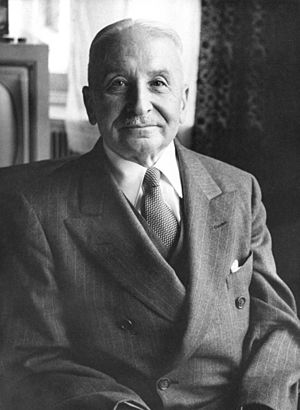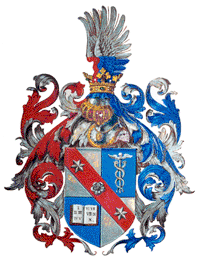Ludwig von Mises facts for kids
Quick facts for kids
Ludwig von Mises
|
|
|---|---|
 |
|
| Born |
Ludwig Heinrich Edler von Mises
29 September 1881 |
| Died | 10 October 1973 (aged 92) New York City, New York, U.S.
|
| Spouse(s) | Margit von Mises |
| Institution |
|
| Field | Economics, political economy, philosophy of science, epistemology, methodology, rationalism, logic, classical liberalism, right-libertarianism |
| School or tradition |
Austrian School |
| Alma mater | University of Vienna |
| Doctoral advisor |
Eugen von Böhm-Bawerk |
| Doctoral students |
|
| Other notable students | |
| Influences | |
| Contributions |
|
| Signature | |
 |
|
Ludwig Heinrich Edler von Mises (German: [ˈluːtvɪç fɔn ˈmiːzəs]; 29 September 1881 – 10 October 1973) was a very important economist, historian, and sociologist from the Austrian School of economics. He wrote and taught a lot about how classical liberalism helps society. Classical liberalism is a political idea that supports individual rights, freedom, and limited government.
Mises is famous for his work on praxeology, which is the study of human action and choices. He also wrote about how different economic systems, like communism and capitalism, work. Many people see him as one of the most important thinkers in economics and politics of the 20th century.
In 1940, Mises moved from Austria to the United States. His ideas have greatly influenced libertarianism, a political philosophy that supports a lot of individual freedom and very little government control. One of his students, Friedrich Hayek, said that Mises was key in bringing back classical liberal ideas after World War II.
Mises had a special group called the "Private Seminar" where many economists met. Many of these students, like Friedrich Hayek, later moved to the United States and Great Britain. Mises taught about seventy close students in Austria.
Contents
Ludwig von Mises's Life Story
Early Years

Ludwig von Mises was born to a Jewish family in a city called Lemberg, which was then part of Austria-Hungary. His father's family became part of the Austrian nobility in the 1800s. The word "Edler" in his name meant they were a noble family without land. His family was involved in building railroads.
By the time he was 12, Mises could speak many languages, including German, Russian, Polish, and French. He could also read Latin and understand Ukrainian. Ludwig had a younger brother, Richard von Mises, who became a famous mathematician. When they were young, their family moved to Vienna.
In 1900, Mises started studying at the University of Vienna. He was very inspired by the ideas of Carl Menger, another important economist. Mises earned his law degree in 1906.
Life and Work in Europe
From 1904 to 1914, Mises attended lectures by the Austrian economist Eugen von Böhm-Bawerk. After getting his law degree, he worked for a short time in Austria's financial government.
He then worked at a law firm in Vienna. Soon after, he started teaching economics. In 1909, he joined the Austrian Chamber of Commerce and Industry. He worked there as an economic adviser for the Austrian government until 1934. During World War I, Mises served in the army and also advised the War Department on economic matters.
Mises was the main economist for the Austrian Chamber of Commerce. He also advised important politicians, like Engelbert Dollfuss, who was the leader of Austria at one point. Later, he advised Otto von Habsburg, who was a politician and claimed to be the rightful heir to the Austrian throne. In 1934, Mises left Austria and moved to Geneva, Switzerland. He became a professor at the Graduate Institute of International Studies there until 1940.
While in Switzerland, Mises married Margit Herzfeld Serény. She was an actress and a widow with a daughter named Gitta Sereny.
Moving to the United States
In 1940, Mises and his wife left Europe because of the war and moved to New York City in the United States. He received support to get a job at American universities. Mises became a visiting professor at New York University in 1945 and taught there until he retired in 1969. A businessman named Lawrence Fertig helped fund Mises's work at the university.
Mises also studied currency issues for the Pan-Europa movement, which aimed to unite European countries. In 1947, Mises helped start the Mont Pelerin Society, a group of scholars who supported free markets.
In 1962, Mises received an important award for his work in economics from the Austrian government. He retired from teaching at 87 and passed away at 92 in New York. His papers and writings are kept at Grove City College, and his personal library is at Hillsdale College.
Mises's Ideas and Impact
Mises wrote and lectured a lot about classical liberalism, which focuses on individual freedom and limited government. In his most famous book, Human Action, Mises explained his idea of praxeology. This is a way of understanding economics by studying how people make choices and act.
Mises believed in economic non-interventionism, meaning the government should not interfere much in the economy. He also was against imperialism, which is when one country tries to control others. He thought that modern wars were much more destructive because they used advanced technology developed by free economies.
In 1920, Mises wrote about the Economic Calculation Problem. This was his criticism of planned economies, like those in socialist countries, where the government controls everything. He argued that without a price mechanism (prices set by supply and demand in a market), it's impossible to know the true value of goods. This means central planners wouldn't know how to use resources efficiently. He believed that "rational economic activity is impossible in a socialist commonwealth" because there would be no real prices for things like machines or raw materials. Mises explained this idea more fully in his 1922 book Socialism: An Economic and Sociological Analysis.
Many friends and students of Mises in Europe became important economists and advisers. These included Friedrich Hayek, who worked with Mises early in his career. Hayek once said that Mises was "one of the best educated and informed men I have ever known." Mises's seminars in Vienna were known for lively discussions among economists.
In New York, Mises continued to attract students to his seminars. Some of his notable American students included Israel Kirzner, Hans Sennholz, and Murray Rothbard. His work also influenced other American thinkers and writers.
The Mises Institute
Because of Ludwig von Mises's important economic ideas, the Mises Institute was started in 1982. This organization offers many free books by Mises and other economists in e-book and audiobook formats. It also has a section for beginners to learn about Austrian Economics. The Mises Institute also offers a graduate school program for students.
Works
Books
- The Theory of Money and Credit (1912)
- Nation, State, and Economy (1919)
- "Economic Calculation in the Socialist Commonwealth" (1920) (article)
- Socialism: An Economic and Sociological Analysis (1922)
- Liberalismus (1927)
- Also known as The Free and Prosperous Commonwealth
- A Critique of Interventionism (1929)
- Epistemological Problems of Economics (1933)
- Memoirs (1940)
- Interventionism: An Economic Analysis (1941)
- Omnipotent Government: The Rise of Total State and Total War (1944)
- Bureaucracy (1944)
- Planned Chaos (1947)
- Human Action: A Treatise on Economics (1949)
- Planning for Freedom (1952)
- The Anti-Capitalistic Mentality (1956)
- Theory and History: An Interpretation of Social and Economic Evolution (1957)
- The Ultimate Foundation of Economic Science (1962)
- The Historical Setting of the Austrian School of Economics (1969)
- Notes and Recollections (1978)
- The Clash of Group Interests and Other Essays (1978)
- On the Manipulation of Money and Credit (1978)
- Economic Policy: Thoughts for Today and Tomorrow (1979, lectures from 1959)
- Money, Method, and the Market Process (1990)
- Economic Freedom and Interventionism (1990)
- The Free Market and Its Enemies (2004, lectures from 1951)
- Marxism Unmasked: From Delusion to Destruction (2006, lectures from 1952)
- Ludwig von Mises on Money and Inflation (2010, lectures from the 1960s)
See Also
 In Spanish: Ludwig von Mises para niños
In Spanish: Ludwig von Mises para niños
- Contributions to liberal theory
- Liberalism in Austria
- List of Austrian School economists
- Mises Institute – Alabama-based think tank
- Thymology

